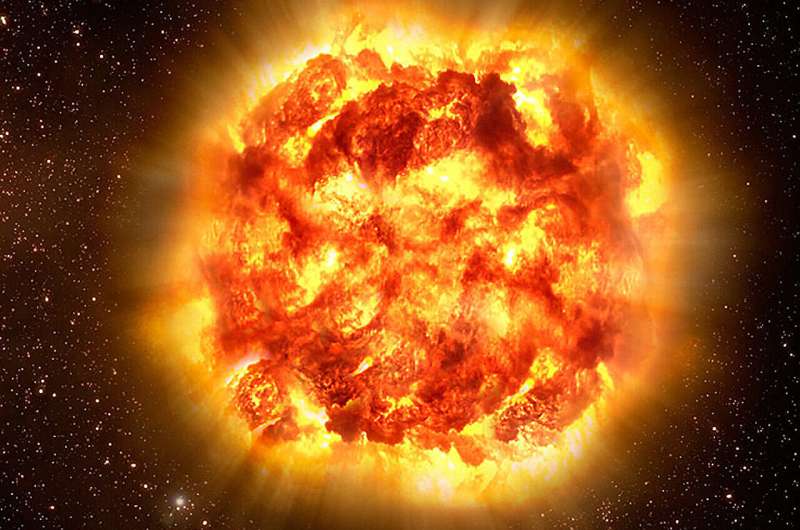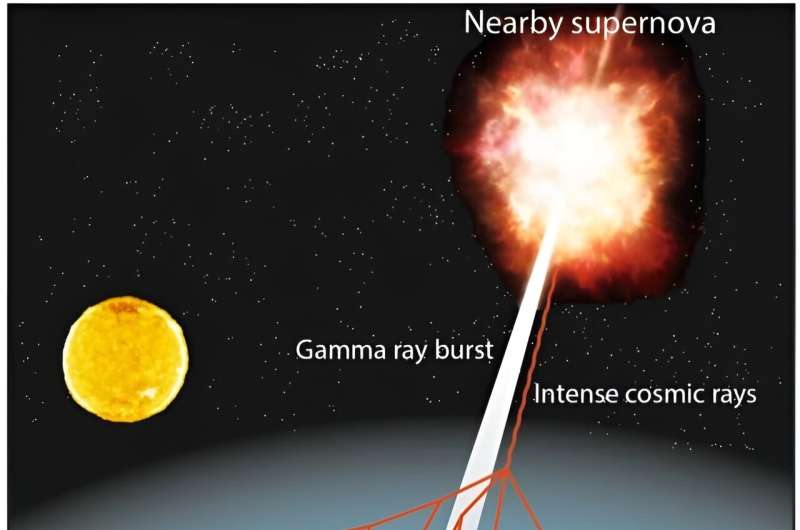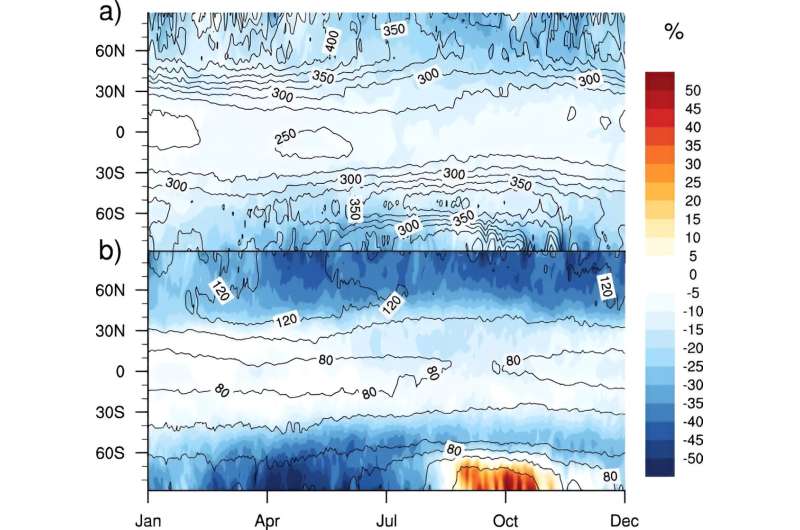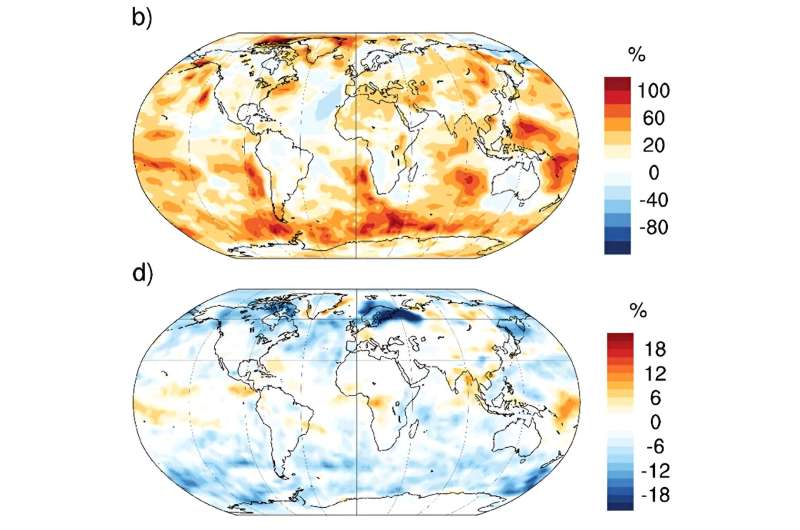
Artist’s impression of a Type II supernova explosion. These supernovae produce gamma rays and powerful ionizing radiation that is dangerous to life. Credit: ESO
Earth’s protective atmosphere has sheltered life for billions of years, creating a haven where evolution produced complex life forms like us. The ozone layer plays a critical role in protecting the biosphere from deadly UV radiation. It blocks 99% of the sun’s powerful UV output. Earth’s magnetosphere also houses us.
But the sun is relatively mild. How effective are the ozone and magnetosphere in protecting us from powerful supernova explosions?
Every million years—a tiny fraction of Earth’s 4.5 billion year lifetime—a massive star explodes within 100 parsecs (326 light years) of Earth. We know this because our solar system is inside a massive bubble in space called the Local Bubble.
It is a cavernous region of space where the density of hydrogen is much lower than outside the bubble. A series of supernova explosions in the previous 10 to 20 million years carved the bubble.
Supernovae are dangerous, and the closer to a planet, the more deadly their effects. Scientists have speculated on the effects that supernova explosions have had on Earth, wondering if they caused mass extinctions or at least partial extinctions.
A supernova’s gamma-ray burst and cosmic rays can deplete Earth’s ozone and allow ionizing UV radiation to reach the planet’s surface. The effects can also create more aerosol particles in the atmosphere, increasing cloud cover and causing global cooling.
A new research article published in Earth and Environment Communications examines supernova explosions and their effect on Earth. It is titled “Earth’s Atmosphere Protects Biosphere from Nearby Supernova”. The lead author is Theodoros Christoudias of the Climate and Atmospheric Research Center, Cyprus Institute, Nicosia, Cyprus.
The Local Bubble is not the only evidence of a near-core-collapse supernova (SNe) in the last few million years. Ocean sediments also contain 60Fe, a radioactive isotope of iron with a half-life of 2.6 million years.
I expel 60Fe in space when they explode, indicating that a nearby supernova exploded about 2 million years ago. There is also 60Fe in sediments indicating another SN explosion about 8 million years ago.

This graphic from the research article shows the potential atmospheric and climate impacts of a nearby supernova. Gamma rays can deplete ozone, allowing more UV radiation to reach the Earth’s surface. Some UV radiation is ionizing, meaning it can damage DNA. Cosmic rays can also create more condensation nuclei, which means more clouds and possible global cooling. Credit: Earth and Environment Communications (2024). DOI: 10.1038/s43247-024-01490-9
Researchers have linked a SN explosion to the Late Devonian extinction about 370 million years ago. In one paper, researchers found plant spores burned by ultraviolet rays, an indication that something powerful depleted Earth’s ozone layer. In fact, Earth’s biodiversity declined for about 300,000 years before the Late Devonian extinction, suggesting that multiple SNe may have played a role.
The Earth’s ozone layer is in constant flux. As UV energy reaches it, it breaks down ozone molecules (O3) separately. This scatters the UV energy and the oxygen atoms combine into O3 again. The cycle repeats itself.
This is a simplified version of the atmospheric chemistry involved, but it serves to illustrate the cycle. A nearby supernova could defeat the cycle, depleting the density of the ozone column and allowing more deadly UV to reach the Earth’s surface.
But in the new paper, Christoudias and his co-authors suggest that Earth’s ozone layer is much more resilient than previously thought and provides sufficient protection against SNe within 100 parsecs. While previous researchers have modeled Earth’s atmosphere and its response to a nearby SN, the authors say they have improved on that work.
They modeled the Earth’s atmosphere with an Earth Systems with Atmospheric Chemistry (EMAC) model to study the impact of SNe explosions near the Earth’s atmosphere. Using EMAC, the authors say they have modeled the “complex dynamics of atmospheric circulation, chemistry and process feedback” of Earth’s atmosphere.
These are needed to “simulate the loss of stratospheric ozone in response to elevated ionization, leading to ion-induced nucleation and particle growth in CCN” (cloud condensation nuclei).
“We assume a representative SN nearby with ionizing GCRs (galactic cosmic rays) in the atmosphere that are 100 times higher than current levels,” they write. This is associated with a supernova explosion about 100 parsecs or 326 light years away.
“The maximum depletion of ozone over the poles is smaller than today’s anthropogenic ozone hole over Antarctica, which amounts to a loss of the ozone column of 60-70%,” the authors explain. “On the other hand, there is an increase in ozone in the troposphere, but it is within the levels resulting from recent anthropogenic pollution.”

These panels from the research paper show the percentage reduction of the ozone column from a 100-fold increase in GCR intensity above nominal. The left vertical axis represents Earth’s latitude, and the x-axis represents the time of year. Ozone loss is more pronounced over the poles due to the effect of the Earth’s magnetosphere, where it is weaker. a is today’s Earth, while b represents an ancient Earth with only 2% oxygen during the Precambrian period. Credit: Earth and Environment Communications (2024). DOI: 10.1038/s43247-024-01490-9
But let’s cut to the chase. We want to know whether the Earth’s biosphere is safe or not.
The average peak stratospheric ozone depletion from 100 times more normal ionizing radiation, representative of a nearby SN, is about 10% globally. This is about the same decline as our anthropogenic pollution causes. It would not affect the biosphere much.
“Although significant, it is unlikely that such ozone changes will have a large impact on the biosphere, particularly because most ozone loss has been found to occur at high latitudes,” the authors explain.
But that’s for modern Earth. During the Precambrian period, before life exploded into a proliferation of forms, the atmosphere had only about 2% oxygen. How would an SN affect this? “We simulated an oxygen atmosphere of 2%, as this likely represents conditions where the developing biosphere on earth would still be particularly sensitive to ozone depletion,” the authors write.
“Ozone loss is about 10%–25% in the mid-latitudes and an order of magnitude lower in the tropics,” the authors write. At minimum ozone levels at the poles, ionizing radiation from a SN can actually end up increasing the ozone column. “We conclude that these atmospheric ozone changes are unlikely to have had a major impact on the developing biosphere on earth during the Cambrian,” they conclude.
What about global cooling?
Global cooling would increase, but not to a dangerous extent. Over the Pacific and Southern Oceans, the CCN can go up to 100%, which sounds like a lot. “These changes, while important from a climatic point of view, are comparable to the contrast between the pristine pre-industrial atmosphere and the polluted atmosphere of today.” They say it would cool the atmosphere by about the same amount we’re warming it now.

These two panels from the research help illustrate the global cooling effect from a nearby SN that exposes Earth to 100 times more ionizing radiation. b shows the fractional change in CCN compared to today. d shows the fractional change in outgoing solar radiation compared to today due to increased cloud albedo. Credit: Earth and Environment Communications (2024). DOI: 10.1038/s43247-024-01490-9
The researchers emphasize that their study concerns the entire biosphere, not individuals. “Our study does not take into account the direct health risks to humans and animals resulting from exposure to high ionizing radiation,” they write.
Depending on individual circumstances, individuals may be exposed to dangerous levels of radiation over time. But overall, the biosphere would hum along despite a 100-fold increase in UV radiation. Our atmosphere and magnetosphere can handle it.
“Overall, we find that nearby SNe are unlikely to have caused mass extinctions on Earth,” the authors write. “We conclude that our planet’s atmosphere and geomagnetic field effectively shields the biosphere from the effects of nearby SNe, which has allowed life to evolve on Earth over the past hundreds of millions of years.”
This study shows that Earth’s biosphere will not suffer much as long as supernova explosions keep their distance.
More information:
Theodoros Christoudias et al, Earth’s atmosphere protects the biosphere from nearby supernovae, Earth and Environment Communications (2024). DOI: 10.1038/s43247-024-01490-9
Provided by Universe Today
citation: Earth’s atmosphere is our best defense against nearby supernovae, study suggests (2024, June 19) Retrieved June 20, 2024 from https://phys.org/news/2024-06-earth-atmosphere-defense-nearby- supernovae.html
This document is subject to copyright. Except for any fair agreement for study or private research purposes, no part may be reproduced without written permission. The content is provided for informational purposes only.